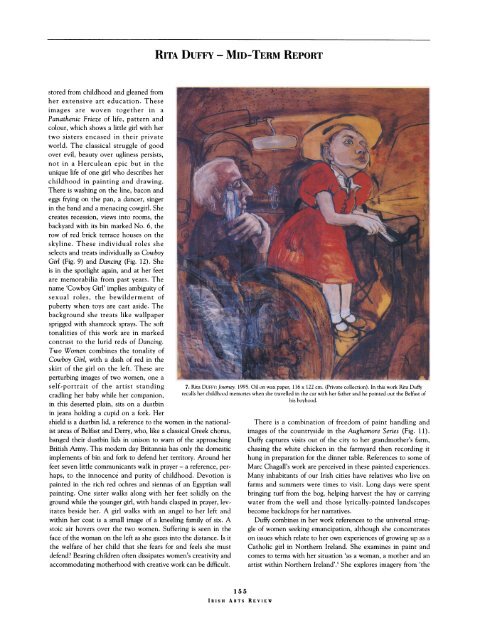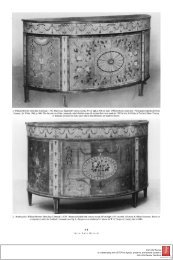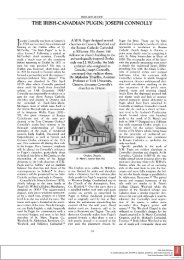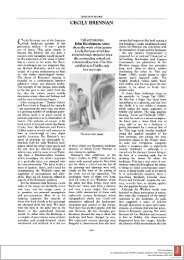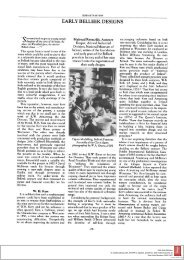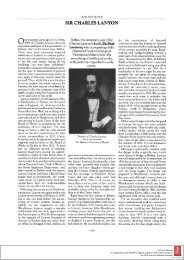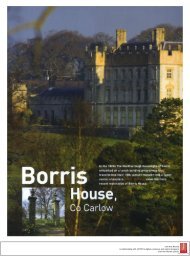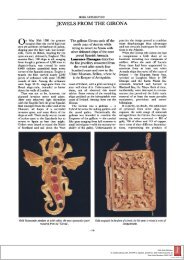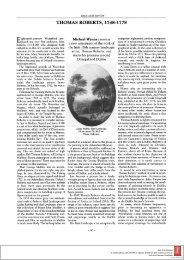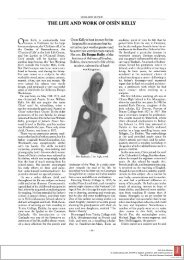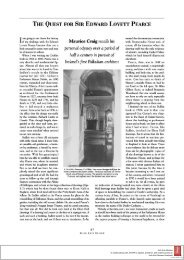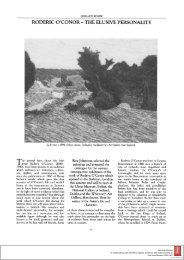RITA DUFFY - MID-TERM REPORT Denise Ferran assesses the art ...
RITA DUFFY - MID-TERM REPORT Denise Ferran assesses the art ...
RITA DUFFY - MID-TERM REPORT Denise Ferran assesses the art ...
You also want an ePaper? Increase the reach of your titles
YUMPU automatically turns print PDFs into web optimized ePapers that Google loves.
stored from childhood and gleaned from<br />
her extensive <strong>art</strong> education. These<br />
images are woven toge<strong>the</strong>r in a<br />
Pana<strong>the</strong>nic Frieze of life, pattern and<br />
colour, which shows a little girl with her<br />
two sisters encased in <strong>the</strong>ir private<br />
world. The classical struggle of good<br />
over evil, beauty over ugliness persists,<br />
not in a Herculean epic but in <strong>the</strong><br />
unique life of one girl who describes her<br />
childhood in painting and drawing.<br />
There is washing on <strong>the</strong> line, bacon and<br />
eggs frying on <strong>the</strong> pan, a dancer, singer<br />
in <strong>the</strong> band and a menacing cowgirl. She<br />
creates recession, views into rooms, <strong>the</strong><br />
backyard with its bin marked No. 6, <strong>the</strong><br />
row of red brick terrace houses on <strong>the</strong><br />
skyline. These individual roles she<br />
selects and treats individually as Cowboy<br />
Girl (Fig. 9) and Dancing (Fig. 12). She<br />
is in <strong>the</strong> spotlight again, and at her feet<br />
are memorabilia from past years. The<br />
name 'Cowboy Girl' implies ambiguity of<br />
sexual roles, <strong>the</strong> bewilderment of<br />
puberty when toys are cast aside. The<br />
background she treats like wallpaper<br />
sprigged with shamrock sprays. The soft<br />
tonalities of this work are in marked<br />
contrast to <strong>the</strong> lurid reds of Dancing.<br />
Two Women combines <strong>the</strong> tonality of<br />
Cowboy Girl, with a dash of red in <strong>the</strong><br />
skirt of <strong>the</strong> girl on <strong>the</strong> left. These are<br />
perturbing images of two women, one a<br />
self-portrait of <strong>the</strong> <strong>art</strong>ist standing<br />
cradling her baby while her companion,<br />
in this deserted olain. sits on a dustbin<br />
in jeans holding a cupid on a fork. Her<br />
shield is a dustbin lid, a reference to <strong>the</strong> women in <strong>the</strong> national<br />
ist areas of Belfast and Derry, who, like a classical Greek chorus,<br />
banged <strong>the</strong>ir dustbin lids in unison to warn of <strong>the</strong> approaching<br />
British Army. This modern day Britannia has only <strong>the</strong> domestic<br />
implements of bin and fork to defend her territory. Around her<br />
feet seven little communicants walk in prayer - a reference, per<br />
haps, to <strong>the</strong> innocence and purity of childhood. Devotion is<br />
painted in <strong>the</strong> rich red ochres and siennas of an Egyptian wall<br />
painting. One sister walks along with her feet solidly on <strong>the</strong><br />
ground while <strong>the</strong> younger girl, with hands clasped in prayer, lev<br />
itates beside her. A girl walks with an angel to her left and<br />
within her coat is a small image of a kneeling family of six. A<br />
stoic air hovers over <strong>the</strong> two women. Suffering is seen in <strong>the</strong><br />
face of <strong>the</strong> woman on <strong>the</strong> left as she gazes into <strong>the</strong> distance. Is it<br />
<strong>the</strong> welfare of her child that she fears for and feels she must<br />
defend? Bearing children often dissipates women's creativity and<br />
accommodating mo<strong>the</strong>rhood with creative work can be difficult.<br />
<strong>RITA</strong> <strong>DUFFY</strong> - <strong>MID</strong>-<strong>TERM</strong> <strong>REPORT</strong><br />
7. Rita <strong>DUFFY</strong>: Jounley. 1995. Oil on wax paper, 116 x 122 cm. (Private collection). In this work Rita Duffy<br />
recalls her childhood memories when she travelled in <strong>the</strong> car with her fa<strong>the</strong>r and he pointed out <strong>the</strong> Belfast of<br />
his boyhood.<br />
155<br />
IRISH ARTS REVIEW<br />
There is a combination of freedom of paint handling and<br />
images of <strong>the</strong> countryside in <strong>the</strong> Aughamore Series (Fig. 11).<br />
Duffy captures visits out of <strong>the</strong> city to her grandmo<strong>the</strong>r's farm,<br />
chasing <strong>the</strong> white chicken in <strong>the</strong> farmyard <strong>the</strong>n recording it<br />
hung in preparation for <strong>the</strong> dinner table. References to some of<br />
Marc Chagall's work are perceived in <strong>the</strong>se painted experiences.<br />
Many inhabitants of our Irish cities have relatives who live on<br />
farms and summers were times to visit. Long days were spent<br />
bringing turf from <strong>the</strong> bog, helping harvest <strong>the</strong> hay or carrying<br />
water from <strong>the</strong> well and those lyrically-painted landscapes<br />
become backdrops for her narratives.<br />
Duffy combines in her work references to <strong>the</strong> universal strug<br />
gle of women seeking emancipation, although she concentrates<br />
on issues which relate to her own experiences of growing up as a<br />
Catholic girl in Nor<strong>the</strong>rn Ireland. She examines in paint and<br />
comes to terms with her situation 'as a woman, a mo<strong>the</strong>r and an<br />
<strong>art</strong>ist within Nor<strong>the</strong>rn Ireland'.' She explores imagery from '<strong>the</strong>


